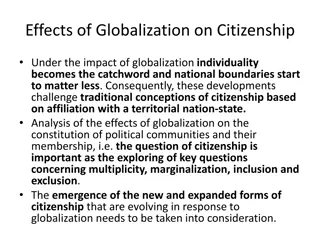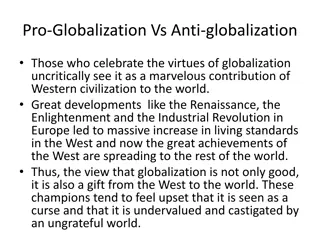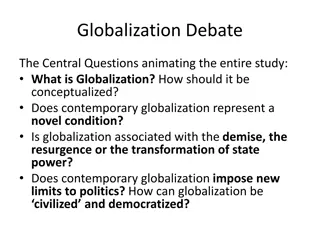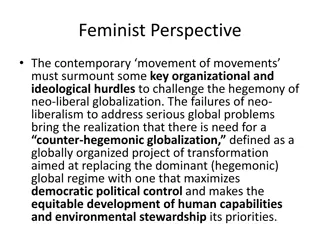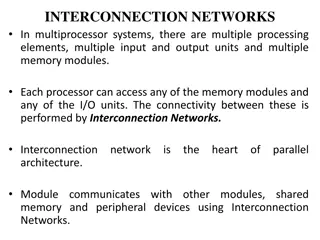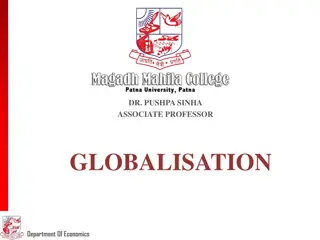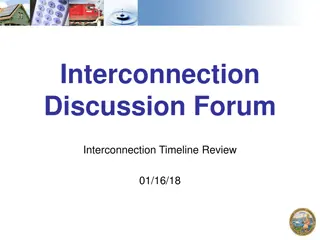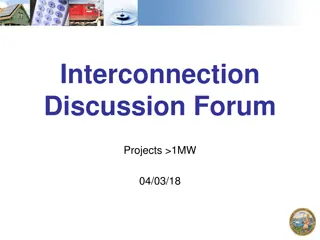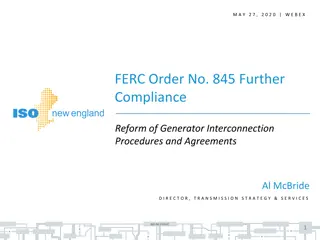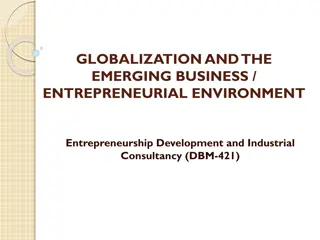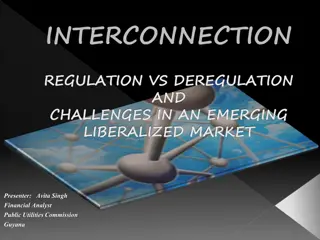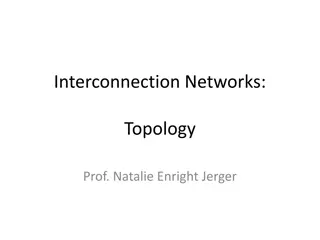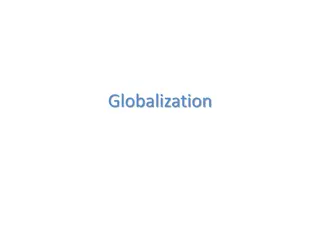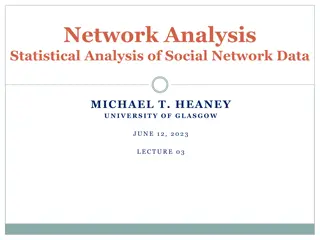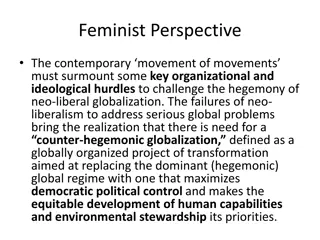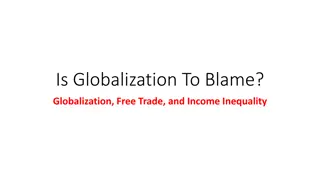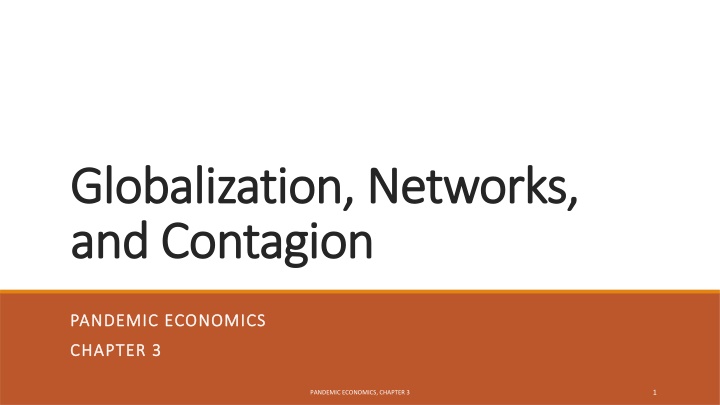
Systems of Interconnection in Globalization Networks
Systems of interconnection play a crucial role in how diseases spread globally, impacted by factors like infectiousness and policy interventions. Understanding the dynamics of globalization, networks, and contagion is essential in managing pandemic economics. Explore the interconnectedness among countries, the implications of globalization on supply chains, and the importance of network applications in various domains.
Download Presentation

Please find below an Image/Link to download the presentation.
The content on the website is provided AS IS for your information and personal use only. It may not be sold, licensed, or shared on other websites without obtaining consent from the author. If you encounter any issues during the download, it is possible that the publisher has removed the file from their server.
You are allowed to download the files provided on this website for personal or commercial use, subject to the condition that they are used lawfully. All files are the property of their respective owners.
The content on the website is provided AS IS for your information and personal use only. It may not be sold, licensed, or shared on other websites without obtaining consent from the author.
E N D
Presentation Transcript
Globalization, Networks, Globalization, Networks, and Contagion and Contagion PANDEMIC ECONOMICS PANDEMIC ECONOMICS CHAPTER 3 CHAPTER 3 1 PANDEMIC ECONOMICS, CHAPTER 3
Topics Topics 1. Systems of Interconnection 2. Globalization 3. Networks 4. Network Applications 5. Contagion 2 PANDEMIC ECONOMICS, CHAPTER 3
Learning Objectives Learning Objectives After reading this chapter, you will be able to: After reading this chapter, you will be able to: LO1 Explain why systems of interconnection cause diseases to spread. LO2 Analyze the process of globalization, the widening and deepening interconnections among the world s peoples through all forms of exchange. LO3 Describe the characteristics of networks. LO4 Discuss network applications, including disease, energy, supply chains, and innovation. LO5 Explain how contagion, the spread of crisis from one area to another, may occur. 3 PANDEMIC ECONOMICS 10
Through networkssystems of interconnection disease outbreaks spread. Because of airline travel, transmission networks span the globe. 1. Systems of 1. Systems of Interconnection Interconnection But the speed in which a disease spreads depends on infectiousness, the degree of interconnection of transmission networks, and the effectiveness of policy interventions. 4 PANDEMIC ECONOMICS, CHAPTER 3
Interconnected Countries Interconnected Countries Interconnected countries assume higher risks of infection. But after the identification of an initial outbreak, countries that close their borders and shut down internal transmission networks have a better chance of containing an outbreak. The carriers of disease in one region will not infect people in others. 5 PANDEMIC ECONOMICS, CHAPTER 3
Globalizationthe widening and deepening interconnections among the world s peoples through all forms of exchange does not imply an inevitable movement toward integration. When resources, goods, and people flow from one area to another, specific networks of globalization, such as supply chains, may strengthen. 2. 2. Globalization Globalization When countries erect barriers and close their borders, integration declines. The point is that, over time, interconnections ebb and flow. 6 PANDEMIC ECONOMICS, CHAPTER 3
Epochs of Globalization Epochs of Globalization In the Oriental Phase I, circa 500 AD to 1100 AD, caravan trade in the Middle East enhanced connections between regions. In the Oriental Phase II, circa 1100 to 1500, urbanization and the Silk Road increased trade, technology, and productivity. In the Multicentric Phase, circa 1500 1800, Europeans expanded trade across the Atlantic Ocean. In the Euro-Atlantic Phase, circa 1800 1950, industrialization, specialization, and division of labor developed the European and North American economies. In the post-World War II Phase, circa 1950 1991, global value chains and multinational corporations in Europe, Japan, and North America experienced the beginning and end of the Cold War. 7 PANDEMIC ECONOMICS, CHAPTER 3
Current Epoch of Globalization Current Epoch of Globalization Circa 1991 present Characterized in several ways, including Thomas L. Friedman s (2005) vision of a flattening world in which technological advances level the economic playing field for countries, companies, and workers. As urbanization expands and more than fifty percent of the world s people now live in cities, Richard Florida s (2005) vision of the current era is that globalization is spiky. 8 PANDEMIC ECONOMICS, CHAPTER 3
Global Flows Global Flows The current epoch of globalization is characterized by global flows the movement of people, resources, goods, capital, and information. The ubiquitous iPhone, manufactured in China, is sold in global markets. French wine, a favorite of many countries for centuries, is sold in markets on five continents. With expanding global flows, many forms of output considered transformational in one period, such as modems, camera phones, and flash drives, become commonplace in the next period. 9 PANDEMIC ECONOMICS, CHAPTER 3
Types of Global Flows Types of Global Flows Interconnected flowscoalesce at different points in time. During picking season, food networks rely on migrant labor, which increases market supply. Multidirectional flowstransport many types of things, including entertainment. Not a one-way process, movies, videos, and music flow from East to West and vice versa. Negative flowscreate friction, such as disease outbreaks or polluting emissions. When sufficiently serious, negative flows stifle economic activity. Reverse flowsproceed in one direction but then turn back on their source. Lines of code may flow from a source to a collaborator, who revises it and sends it back. 10 PANDEMIC ECONOMICS, CHAPTER 3
Global Arrangements Global Arrangements While the world is characterized by the flows of people, goods, resources, information, technology, and capital, global arrangements may either expedite or establish barriers to those flows. Trade agreements, country borders, regulatory agencies, standards, and customs may enhance, hinder, or block global flows. The point is that the current epoch of globalization includes an interplay between arrangements and flows, a simultaneous movement toward openness and oversight. 11 PANDEMIC ECONOMICS, CHAPTER 3
A network or web is a system of interconnected elements that includes a set of agents or nodes and a set of connections that link them. A node is a physical point in which connections intersect. 3. Networks 3. Networks The structure of nodes and connections differs according to the system under consideration. For example, a communication network in a business environment facilitates economic activity, so nodes include all members of the organization while links include the pathways of communication. 12 PANDEMIC ECONOMICS, CHAPTER 3
Identification of Network Structure Identification of Network Structure To identify network structure, common queries include: The degree of small-worldness (when most nodes are not neighbors but may reach each other with a small number of links). Scale-free (when the characteristics of the network are independent of the size of the network, so if the network grows its structure remains the same). Within a network structure, different methods of transmission, connections, and shocks impact flows. 13 PANDEMIC ECONOMICS, CHAPTER 3
The Importance of Networks for Economists The Importance of Networks for Economists First, the expansion of game theory the study of mutual interdependence, strategies, and payoffs provides a network perspective. Second, important economic applications include communication networks, cellphones, and social media. Third, the rise of data and computing power has encouraged research on networks. Fourth, the growth of network research in economics patterns the growth of network research in related fields, including computer science and finance. 14 PANDEMIC ECONOMICS, CHAPTER 3
Network Structure Network Structure A network or web (W) includes two sets, nodes N = {n1, n2, , nn} and connections (C): Examples of nodes include computers, bridges, companies, researchers, suppliers, and infected individuals. For an ordered pair of nodes n1 and n2, a connection is defined as a link or pathway between them: c(n1, n2). W = (N, C) 15 PANDEMIC ECONOMICS, CHAPTER 3
Example Example A network with a set of six nodes in physical space: N = {n1, n2, n3, n4, n5, n6} Normalizing the distance between any two adjacent nodes to unity, the model identifies c(n1, n2) = 1 as the shortest path between nodes, represented with solid lines. 16 PANDEMIC ECONOMICS, CHAPTER 3
Social Networks Social Networks Agents who are geographically distanced may interact in social networks. In social networks, ongoing value-generating flows F = {f1, f2, , fn} are overseen by network agents. For example, in an organizational network, the flow of information (f1) between two nodes may accompany the flow of technology (f2) between two other nodes. 17 PANDEMIC ECONOMICS, CHAPTER 3
Distance Distance The distance in a social network between nodes (n, nn) entails the shortest pathway, which may be greater than, equal to, or less than their geographic distance c(n, nn). The physical distance between n2 and n6, c(n2, n6) = 2 (solid lines) is greater than the distance of the social connection (n2, n6) = 1 (dotted line). This reality means that the social network which includes both business and personal connections is the main channel through which agents discover new opportunities. 18 PANDEMIC ECONOMICS, CHAPTER 3
Superspreaders Superspreaders Networks demonstrate the potential existence of a set of superspreadersS = {s1, s2, , sn}, nodes or hubs that facilitate a high degree of network flow. In social networks, superspreaders have a relatively large number of connections and spread the most information. In technology networks, superspreaders are the individuals or companies, well connected, that innovate and spread new technology in the network. 19 PANDEMIC ECONOMICS, CHAPTER 3
Disease Disease Transmission Transmission When a disease appears in a transmission network, a superspreader (s1) spreads the disease to others, creating an outbreak. 20 PANDEMIC ECONOMICS, CHAPTER 3
Transmission Potential Transmission Potential In a disease outbreak, early epidemiological studies assumed that susceptible nodes had equal chance of infection. But subsequent studies documented heterogeneity in transmission: some people have a greater propensity of infecting others. What emerged as the 20/80 rule, a concept found in empirical studies in epidemiology, 20 percent of a given population is thought to hold 80 percent of the transmission potential. 21 PANDEMIC ECONOMICS, CHAPTER 3
Systematic differences between networks exist across income levels, regions, and political predilections but they facilitate global flows. It is now easier than ever to communicate, distribute, and innovate but also spread disease. 4. Network 4. Network Applications Applications Although not mutually exclusive, the networks relevant to pandemic economics include, but are not limited to, disease, energy, supply chain, and innovation. The result of these networks is an ever- expanding web of linkages. 22 PANDEMIC ECONOMICS, CHAPTER 3
Disease Networks Disease Networks Suppose targeted interventions (X) are successful in severing connections between a superspreader (s1) and individuals n1, n2, n3. An example is an infectious person who travels through an airport (superspreader event one), flies on a plane (superspreader event two), and upon arrival attends a large gathering with family and friends (superspreader event three). Depending on characteristics of the event, connected agents may be exposed, infected, or susceptible. 23 PANDEMIC ECONOMICS, CHAPTER 3
24 PANDEMIC ECONOMICS, CHAPTER 3
Energy Network Energy Network Energy networks interrelated markets of energy sources, transmission, and distribution include links between consumer nodes and energy resources. Within an energy network, several sectors exist, including power, electricity, fuel, buildings, industry, and transportation. 25 PANDEMIC ECONOMICS, CHAPTER 3
Supply Chain Networks Supply Chain Networks Supply chains value-adding activities that start with raw materials and end with consumption both characterize the current epoch of globalization and demonstrate how a pandemic may impact the global economy. In global supply chains, different nodes exist, including companies that spread their production processes across suppliers and countries, and consumers that demand output. 26 PANDEMIC ECONOMICS, CHAPTER 3
Innovation Networks Innovation Networks Innovation networks include agents who create and develop new products, services, and production methods. In these networks, variations across performance and regions depend on two sets of factors. One set includes resources, data, and information. The other set includes organizational and institutional structures, human capital, capabilities, and knowledge. 27 PANDEMIC ECONOMICS, CHAPTER 3
In networks, contagionthe spread of crisis from one area to another may occur in two ways. One, contagion may occur when something spreads in a network, such as the flow of disease (fd) infecting members of a community. In this context, contagion is contained to the network under consideration. 5. Contagion 5. Contagion Two, if networks are interdependent, they are vulnerable to shocks that begin in one network and spread to other networks. 28 PANDEMIC ECONOMICS, CHAPTER 3
Disease Contagion ( Disease Contagion (f fd d) Flows from One Network to Another ) Flows from One Network to Another 29 PANDEMIC ECONOMICS, CHAPTER 3
Contagion and Negative Flows Contagion and Negative Flows When contagion spreads between networks, it may entail the same or different negative flows. An example of the former is the flow of a disease. An example of the latter, the Asian financial crisis of 1997, occurred when a series of currency devaluations began in Thailand, spread to other east-Asian countries, and raised fears about a regional or global economic meltdown. Because financial networks link to economic networks, the Asian financial crisis led to the collapse of banks, decrease in investment, and decrease in the production of output. 30 PANDEMIC ECONOMICS, CHAPTER 3
Contagion as a Process Contagion as a Process Disease may spread in global transmission networks, creating a healthcare crisis. This leads to a decrease in the production of output, recession, and rising unemployment, as countries lock down their economies. As business investment declines, bankruptcies and layoffs rise. Following the economic crisis is the danger of a financial crisis with countries and companies defaulting on loans. 31 PANDEMIC ECONOMICS, CHAPTER 3
Contagion as a Process (continued) Contagion as a Process (continued) Countries with the highest levels of debt per GDP are at the greatest risk as they borrow money to combat economic downturns. For many companies, revenue generation is too low to make interest payments on debt, so they issue new debt. The debt problems cause investors to become pessimistic. As these epidemiological, economic, and financial problems unfold, contagion spreads to developing countries. As a result, infections rise and economic activity declines. 32 PANDEMIC ECONOMICS, CHAPTER 3
Lessons of Contagion Lessons of Contagion First, the more that networks are integrated, the more likely negative flows will spread across regions. Second, as governments borrow beyond their means, they are likely to experience budget crises when economic and financial activity decline. Third, the longer the initial outbreak continues to spread, the greater the risk of contagion. Fourth, an inability of countries to stop economic, epidemiological, and financial crises leads to a greater likelihood that contagion will infect multiple networks. 33 PANDEMIC ECONOMICS, CHAPTER 3



